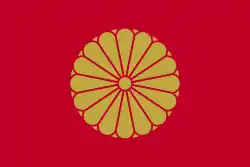Sentō Imperial Palace
In Japan, the Sentō Imperial Palace (仙洞御所, Sentō gosho, litt. "Emeritus Imperial Palace") traditionally does not refer to a single location, but to any residence of retired emperors. Before Akihito abdicated in 2019, the last Emperor to retire did so in 1817, so the designation commonly refers to the historical Kyoto Sento Imperial Palace (京都仙洞御所).
Kyoto Sentō Imperial Palace

The Kyoto Sentō Imperial Palace (京都仙洞御所, Kyoto Sentō-gosho) 22 acres (89,000 m2)) is a large garden in Kyoto, Japan, formerly the grounds of a palace for retired emperors. It is administered by the Imperial Household Agency and is opened to visitors.
History
Sento Imperial Palace was completed in 1630 for Emperor Go-Mizunoo's retirement, along with the corresponding Ōmiya Palace for the Empress Dowager Nyoin. Both palaces were repeatedly destroyed by fire and reconstructed until a blaze in 1854, after which the Sento palace was never rebuilt. (Ōmiya Palace was, however, reconstructed in 1867 and is still used by the emperor whenever he visits Kyoto). Today only two Sento structures, the Seika-tei and Yushin-tei teahouses, remain. The excellent gardens, laid out in 1630 by renowned artist Kobori Masakazu (Kobori Enshu), are now its main attractions.
Layout
The palace grounds are located within the southeast corner of the Kyoto Imperial Palace, and entered via a stately wooden gate within its surrounding earthen wall. A carriage house with graceful triple gables sits just within, but still outside the garden's unadorned inner wall, whose gate leads directly to a fine view opening westward across the garden pond.
The garden's primary feature is a large pond with islands and walkways, whose north and south segments were linked by a short canal in 1747. The north pond was extended and reworked from 1684-1688; the south pond is notable for its expansive "ocean shore" of rounded stones and cherry trees, an edging of mixed natural and hewn stones, and a separate, understated embankment of squared stones. The ponds contain a variety of highly picturesque islands and six bridges in a varied styles, including one with an impressive wisteria trellis (built 1895).
Two teahouses complete the garden: Seika-tei, single-roofed and spare, at the southern end of the south pond; and Yushin-tei, thatched and rustic with a notable round window, at the western side of the north pond.
 A bridge
A bridge Mossy hills
Mossy hills Pond through trees
Pond through trees Seika-tei
Seika-tei Yushin-tei
Yushin-tei
Modern Sentō Imperial Palace
Akihito abdicated on 30 April 2019. Until he moved out of the Fukiage Palace located on the grounds of the Imperial Palace on March 31, 2020, the Fukiage Palace was named Fukiage Sentō Imperial Palace (吹上仙洞御所, Fukiage Sento Gosho). Until the Akasaka Palace[1] is refurbished to accommodate to his old age, he is living temporarily in the Takanawa Residence, who became the Temporary Sentō Imperial Palace (仙洞仮御所, Sento Kari Gosho).[2]
References
- "新たな皇室のお住まいは" [The residences of the new Imperial family]. NHK.
- "上皇ご夫妻、31日に仙洞仮御所へ 高輪皇族邸を改修" [Their majesties to move in on March 31st to the Emeritus Imperial Palace, Takanawa residence refurbished]. Asahi Shibun. 13 March 2020. Retrieved 13 July 2020.
![]() Media related to Sento Imperial Palace at Wikimedia Commons
Media related to Sento Imperial Palace at Wikimedia Commons
- Imperial Household Agency | Sento Imperial Palace
- Kyoto Travel Guide article
- Imperial Household Agency, Sento-Gosho (Ex-Emperor's Palace), undated booklet (August 2007).
- David Young, Michiko Young, The Art of the Japanese Garden, Tuttle Publishing, 2005, page 132. ISBN 0-8048-3598-5.
External links
| Wikimedia Commons has media related to Sento Imperial Palace. |
